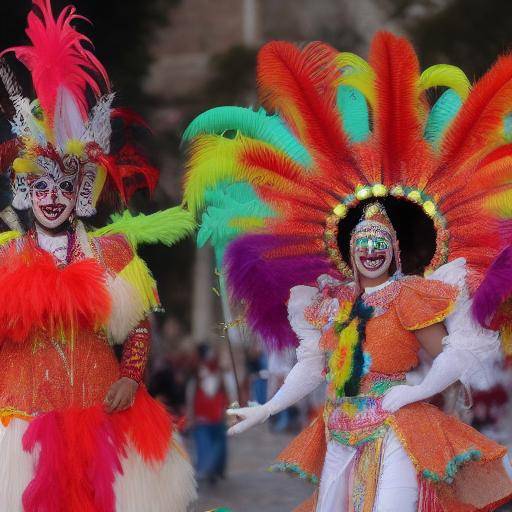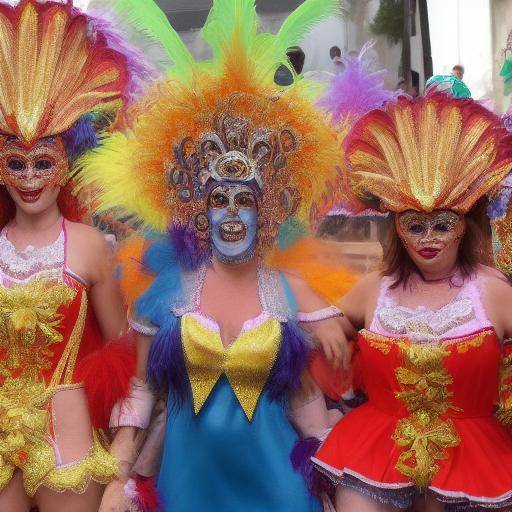
The Rio Carnival is a world-renowned festival that encapsulates the history, culture and tradition of Brazil. This article offers an enriching journey through the history of the Carnival of Rio, the cultural relevance of Brazil and the upholstery of the carioca tradition. We will explore from their humble origins to their evolution as an emblematic celebration that unites people from around the world in an explosion of color, music and joy. Throughout this article, we will discover history in depth, analyze its cultural impact and offer valuable ideas about this enigmatic holiday.
Introduction
The Rio Carnival, the largest and most famous carnival in the world, is an annual celebration that attracts millions of attendees from all over the globe. This carnival is a unique cultural immersion in Brazil's most lively tradition, which merges the African, indigenous and European heritage in a spectacular way. From its origins to its current state as a global phenomenon, the Rio Carnival remains a symbol of diversity, inclusion and exuberance. Throughout this article, we will delve into the multicolored history of the Carnival of Rio, explore the rich history of Brazil that feeds this festivity and penetrate the roots of the carioca tradition, which defines the essence of carnival.
History and Background
The Origins of the Rio Carnival
The Rio Carnival has its roots in the pagan holidays that the Portuguese took to Brazil during the colonial period. These festivities were inspired by traditional European celebrations, but quickly evolved by blending with the African and indigenous influences present in Brazil. The lush fusion of cultures made the Carnival of Rio acquire its own unique identity, highlighting the traditions, music and dance that characterize it to this day.
Historical Development
The Rio Carnival has been transformed over the years, from its modest beginnings to becoming a world-renowned event. In the 19th century, the first carnival societies and organized parades emerged, marking the beginning of sophistication and competition between different groups to produce the most impressive exhibition. As the Rio Carnival increased its popularity, it became a showcase for the rich cultural diversity of Brazil, with parades full of glamour, vibrant music and dazzling theatrical shows.
Significant Moments and Emblematic Figures
Throughout its history, the Rio Carnival has witnessed significant moments that have contributed to its current status. From the foundation of the first samba schools to the consolidation of the parade competitions, the carnival has been shaped by emblematic figures that have played a crucial role in its evolution. These figures include musicians, costume designers, choreographers and community leaders who have contributed to the expansion and evolution of the festival.
Deep analysis
Benefits and Challenges
The Rio Carnival represents a unique opportunity to boost the local economy, promote cultural tourism and preserve cultural traditions in a globalized world. However, it also faces challenges such as the sustainable management of natural resources, the preservation of cultural authenticity and the social inclusion of all communities involved in carnival.
Current trends
Current trends in the Rio Carnival include a renewed approach to sustainability, the integration of technologies to improve the experience of attendees, and a greater emphasis on diversity and inclusion in all aspects of the carnival. These trends reflect the continuing evolution of the festivities to adapt to a constantly changing world.
Varied perspectives
The Rio Carnival is the subject of various perspectives, from artistic and cultural vision to economic and social considerations. The debates around marketing, community participation and the preservation of the authentic roots of carnival reveal the complexities surrounding this emblematic holiday.
Comprehensive review
Applications and Best Practices
The Rio Carnival is a fascinating example of how cultural traditions can be used to promote socio-economic development, cultural identity and community cohesion. Best practices arising from carnival, such as intercultural collaboration, the promotion of art and the preservation of cultural heritage, can be applied in global contexts to foster diversity and intercultural understanding.
Perspectives of Experts and Future
The experts emphasize the importance of preserving the authenticity and essence of the Rio Carnival in the midst of its global expansion. Looking forward, there is a need for greater integration of interactive technologies to improve public participation, as well as greater attention in the documentation and preservation of ancestral traditions.
Comparative analysis
Carnival of Rio, History of Brazil and Carioca Tradition
The intrinsic link between the Carnival of Rio, the history of Brazil and the Carioca tradition is evident through the interconnection of symbols, musical rhythms and artistic expressions. While carnival is a reflection of cultural diversity and creativity, the history of Brazil and the Carioca tradition provide the historical and cultural context that gives life to this monumental celebration.
Similarities and Variances
Despite its similarities, the Rio Carnival is distinguished by its monumental scale, attracting visitors from around the world, while the history of Brazil and the Carioca tradition inform the cultural depth of carnival. This interrelation contributes to the uniqueness and multiform celebration that is the Rio Carnival.
Practical Tips and Accessible Tips
The Secrets of the Rio Carnival
- Plan your visit ahead: Due to the large influx of visitors, it is crucial to plan ahead to ensure a rewarding experience.
- Stay in the local culture: Beyond the main parades, explore the neighborhoods and find smaller events that offer an authentic view of the Rio Carnival.
- Respect local culture: By participating in the festival, respect local traditions and practices to contribute to a culturally enriching experience.
Industry Perspectives and Expert Reviews
Authorized votes
"The Rio Carnival is a cultural treasure that transcends the borders of Brazil, encapsulating the festive spirit and diverse identity of a whole nation." - María Silva, historian and expert in cultural anthropology.
"The art of the Rio Carnival is a celebration that merges the old and the modern, creating a visual spectacle that reflects the essence of the history of Brazil and the Carioca tradition." - Carlos Nunes, costume designer and expert in folk art.
Case Studies and Real Life Applications
Celebrating Cultural Identity
The Rio Carnival has served as an outstanding case of how a cultural holiday can foster community cohesion, boost the economy and project a positive image of a region. This impact is reflected in the promotion of tourism, the empowerment of local communities and the preservation of centuries-old traditions.
Future Trends and Predictions
Looking to the Horizon
The Rio Carnival is expected to continue to expand as a global platform for creative expression and the promotion of cultural diversity. Future trends aim at greater integration of technological initiatives to improve the participation of viewers, as well as a renewed emphasis on the sustainability and preservation of cultural roots.
Conclusion
The Rio Carnival is much more than an annual holiday; it is a testimony of the unifying power of culture, human creativity and the celebration of diversity. Throughout this article, we have explored the colorful and significant history of the Rio Carnival, understanding its deep connection with the history of Brazil and the Carioca tradition. This unique holiday incarnates the rich mix of cultural influences that characterize Brazil, and remains a beacon of joy and vitality that attracts people from around the world.
Frequently asked questions
What is the story of the Rio Carnival?
The Rio Carnival has its origins in European festivities carried to Brazil during the colonial period, which mixed with African and indigenous influences to create a unique celebration.
How has the Rio Carnival evolved over the years?
The Rio Carnival has gone from modest celebrations to a world-renowned event, with elaborate parades, vibrant music and a mix of cultural traditions.
What are the benefits and challenges of the Rio Carnival?
The Rio Carnival promotes the local economy and promotes cultural tourism, but also faces challenges in sustainable resource management and the preservation of cultural authenticity.
How can someone participate or enjoy the Rio Carnival?
Planning ahead, immersed in local culture and respecting traditions, visitors can fully enjoy the Rio Carnival.
What is the importance of the Rio Carnival in Brazil's cultural identity?
The Rio Carnival reflects the cultural diversity and creativity of Brazil, projecting a positive image of the nation and fostering community cohesion.
What are the future trends of the Rio Carnival?
The integration of technologies to improve public participation and a renewed approach to the sustainability and preservation of cultural traditions are emerging trends.
Through this journey through the history of the Carnival of Rio, the rich heritage of Brazil and the essence of the Carioca tradition, the magnitude and beauty of this holiday is revealed. This annual celebration, in all its greatness and diversity, continues to captivate hearts and define a cultural legacy that transcends borders. May the Rio Carnival continue to shine as a beacon of joy and unity for generations to come.



